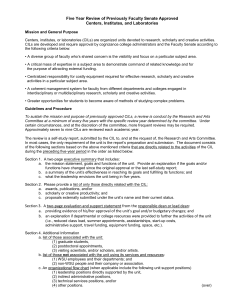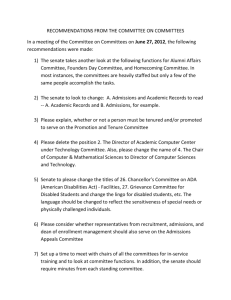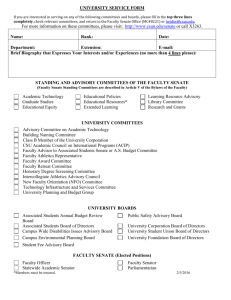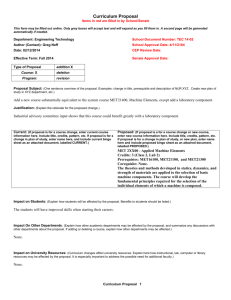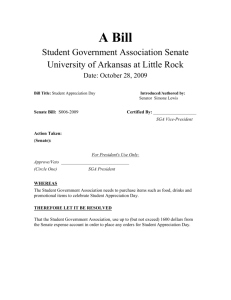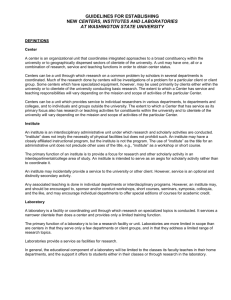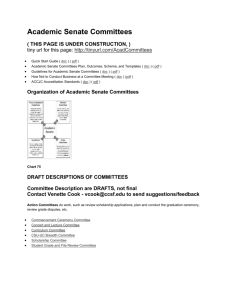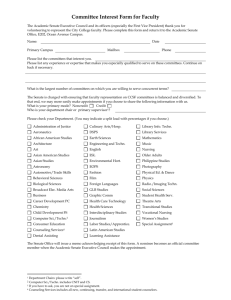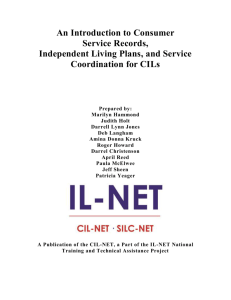Center, Institute or Laboratory - Faculty Senate Home
advertisement
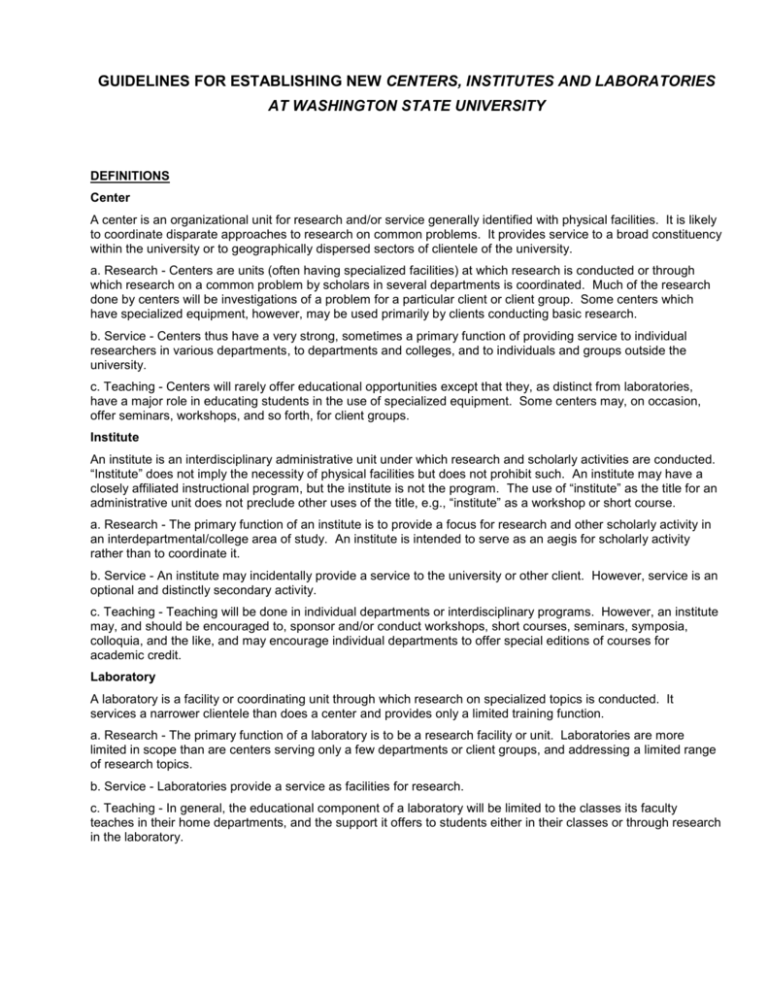
GUIDELINES FOR ESTABLISHING NEW CENTERS, INSTITUTES AND LABORATORIES AT WASHINGTON STATE UNIVERSITY DEFINITIONS Center A center is an organizational unit for research and/or service generally identified with physical facilities. It is likely to coordinate disparate approaches to research on common problems. It provides service to a broad constituency within the university or to geographically dispersed sectors of clientele of the university. a. Research - Centers are units (often having specialized facilities) at which research is conducted or through which research on a common problem by scholars in several departments is coordinated. Much of the research done by centers will be investigations of a problem for a particular client or client group. Some centers which have specialized equipment, however, may be used primarily by clients conducting basic research. b. Service - Centers thus have a very strong, sometimes a primary function of providing service to individual researchers in various departments, to departments and colleges, and to individuals and groups outside the university. c. Teaching - Centers will rarely offer educational opportunities except that they, as distinct from laboratories, have a major role in educating students in the use of specialized equipment. Some centers may, on occasion, offer seminars, workshops, and so forth, for client groups. Institute An institute is an interdisciplinary administrative unit under which research and scholarly activities are conducted. “Institute” does not imply the necessity of physical facilities but does not prohibit such. An institute may have a closely affiliated instructional program, but the institute is not the program. The use of “institute” as the title for an administrative unit does not preclude other uses of the title, e.g., “institute” as a workshop or short course. a. Research - The primary function of an institute is to provide a focus for research and other scholarly activity in an interdepartmental/college area of study. An institute is intended to serve as an aegis for scholarly activity rather than to coordinate it. b. Service - An institute may incidentally provide a service to the university or other client. However, service is an optional and distinctly secondary activity. c. Teaching - Teaching will be done in individual departments or interdisciplinary programs. However, an institute may, and should be encouraged to, sponsor and/or conduct workshops, short courses, seminars, symposia, colloquia, and the like, and may encourage individual departments to offer special editions of courses for academic credit. Laboratory A laboratory is a facility or coordinating unit through which research on specialized topics is conducted. It services a narrower clientele than does a center and provides only a limited training function. a. Research - The primary function of a laboratory is to be a research facility or unit. Laboratories are more limited in scope than are centers serving only a few departments or client groups, and addressing a limited range of research topics. b. Service - Laboratories provide a service as facilities for research. c. Teaching - In general, the educational component of a laboratory will be limited to the classes its faculty teaches in their home departments, and the support it offers to students either in their classes or through research in the laboratory. GENERAL PURPOSES 1. Provide additional visibility to a defined area of study important to the university. 2. Provide a focus for a group of faculty from diverse disciplines who are concerned about the same subject. 3. Provide a critical mass of expertise in a subject area to demonstrate command of all related knowledge for the purpose of attracting external funding. 4. Provide centralized responsibility for costly equipment required for effective research in a particular subject area. 5. Provide a more intimate management system for faculty from different departments and colleges engaged in interdisciplinary or multidisciplinary research. 6. Provide greater opportunities for students to become aware of methods of studying large complex problems having a broad ecology of interacting factors. ESTABLISHING NEW UNITS The Faculty Senate and its committees will review and approve those centers, institutes and laboratories (CILs), prior to their establishment, following the procedures described herein. Requests for the establishment of new CILs should be as follows: A proposal should be sent to the Faculty Senate Office which will address the following: 1. Name of the unit. 2. Nature and scope of its activities. 3. Criteria and method of selection of director and the director’s term of office needs to be specified. Participating faculty members associated with the proposed CIL need to be listed and their vita included. Both special criteria for membership in a CIL and the process of selecting members should be spelled out in this section. 4. The college(s) and/or department(s) to be involved. 5. Amount of budgetary support requested. The specific levels of support should be addressed in the proposal. 6. Expected funding needed from university, state, external awards or gift sources. 7. Needs for space, equipment, and supplies (currently available and needed now). 8. Expected contribution to and impact on the instructional programs. 9. Expected contribution to university and other clients. 10. Supporting letters from chairs, deans, vice provosts, and/or other individuals to whom the unit director will report. 11. Of particular interest will be the function of the proposed unit relative to the university community, its organization and administration, requisite financial and staff support, space requirements, and other requested university resources. Copies of the proposal will be distributed to the following Faculty Senate Committees as determined to be appropriate by the Senate staff. Persons preparing proposals should contact the Faculty Senate Office to obtain details about the information which should be included for review by specific committees. Research and Arts Committee (lead committee) Academic Affairs Committee Budget Committee Graduate Studies Committee Library Committee University Planning Committee * The director and members of the board of advisors, faculty or staff of the proposed CILs should be prepared to present their proposal to the Faculty Senate committees, answer their questions and respond to requests for amplifying documentation. The committees must be consulted and must react, in writing, to the proposal for the establishment of a CIL as defined under Definitions before the recommendations are determined. The committees will then forward their recommendations to the lead committee and/or the Faculty Senate Office. Upon completion of reviewing the proposal, determining that all documentation is in order, and the other committee recommendations have been addressed, the Research and Arts Committee, may refer the proposal to other Faculty Senate committees for review if deemed advisable, or forward it directly to the Faculty Senate with recommendation on how to proceed for debate and action for approval or disapproval of the proposal. The CIL proposal with the lead committee recommendation is placed on the next Faculty Senate agenda as a discussion item. The chair of the lead committee and/or a representative/author of the proposal will be asked to present and defend the CIL proposal to the Faculty Senate members. At the next meeting of the Faculty Senate the proposal with recommendation is placed as an action item with lead committee chair/proposal representative being present a second time to answers questions of the members before the final vote is placed for approval or disapproval. * When there is a legislative request for planning money for a proposed CIL, the University Planning Committee recommends that it review the organizational concept during the process of requesting the planning money; then, if the planning is funded, the University Planning Committee and other relevant Faculty Senate committees will be more actively involved in the detailed planning and development of the larger request for implementation money. STRUCTURE Governance/Administration 1. Each CIL will be administered by a director. The director will report to the dean of the college of designee responsible for the support of the unit. In the event that more than one college is involved, the concerned deans will serve as an advisory committee for the unit and will select a dean to serve as the lead to whom the director reports. For those CILs budgeted through central administrative offices, an appropriate central administrative officer will serve as administrator and the deans of the interested colleges and other appropriate persons may constitute an advisory committee to that officer. 2. lnter-institutional CILs for which WSU serves as the coordinating institution will normally be the responsibility of the appropriate central administrative officer. Advisory committees of concerned deans within the university will be constituted to provide advice as necessary. 3. Each CIL may have a program advisory committee of at least three and no more than ten members of the faculty appointed by the administrative officer to provide suggestions for operation of the unit to the director, the administrative advisory committee and the administrative officer. Students 1. Students may be affiliated with CILs for employment, but must be attached to relevant academic departments or programs for advisement, course enrollments and degree-seeking purposes. 2. Courses for academic credit will be offered only through the relevant department or program. Faculty All faculty affiliated with CILs will normally be members of academic departments or programs. In the event of joint appointments between academic departments and CILs, the units shall share the responsibilities for appointment, promotion, and tenure. Funding 1. The university shall support CILs to the following extent: a. An appropriate portion of the salary and benefits for the director, associate and/or assistant director or other professional support as approved. b. A portion of the salary and benefits for clerical personnel and other support personnel as approved. C. Office support and equipment at a level commensurate with the goals and mission of the undertaking. 2. The CIL may be supported in whole or in partnership with: a. state funds b. financial and administrative funds (Indirect Cost) c. external awards d. gifts EVALUATIONS Each Faculty Senate approved CIL will be reviewed by the Research and Arts Committee, in consultation with the Vice Provost for Research, every five to seven years. The specific year assigned for the unit’s review will be determined by the Research and Arts Committee. Under extraordinary circumstances, and at the discretion of the Research and Arts Committee, more frequent reviews may be required. The committee will evaluate and approve the continued operation of the unit if it meets the following general criteria: Unit’s goals continue to be reasonable approximations of those originally approved. Unit is satisfactorily fulfilling its state goals and functions. To acquire a copy of the complete guidelines for evaluating approved CILs, contact the Faculty Senate Office or the Office of Grant and Research Development. Approved by university Senate - 2/28/80 Revised - 4/10/90 Revised - 4/2/92 Revised - 3/3/94 Revised – 10/09/02
